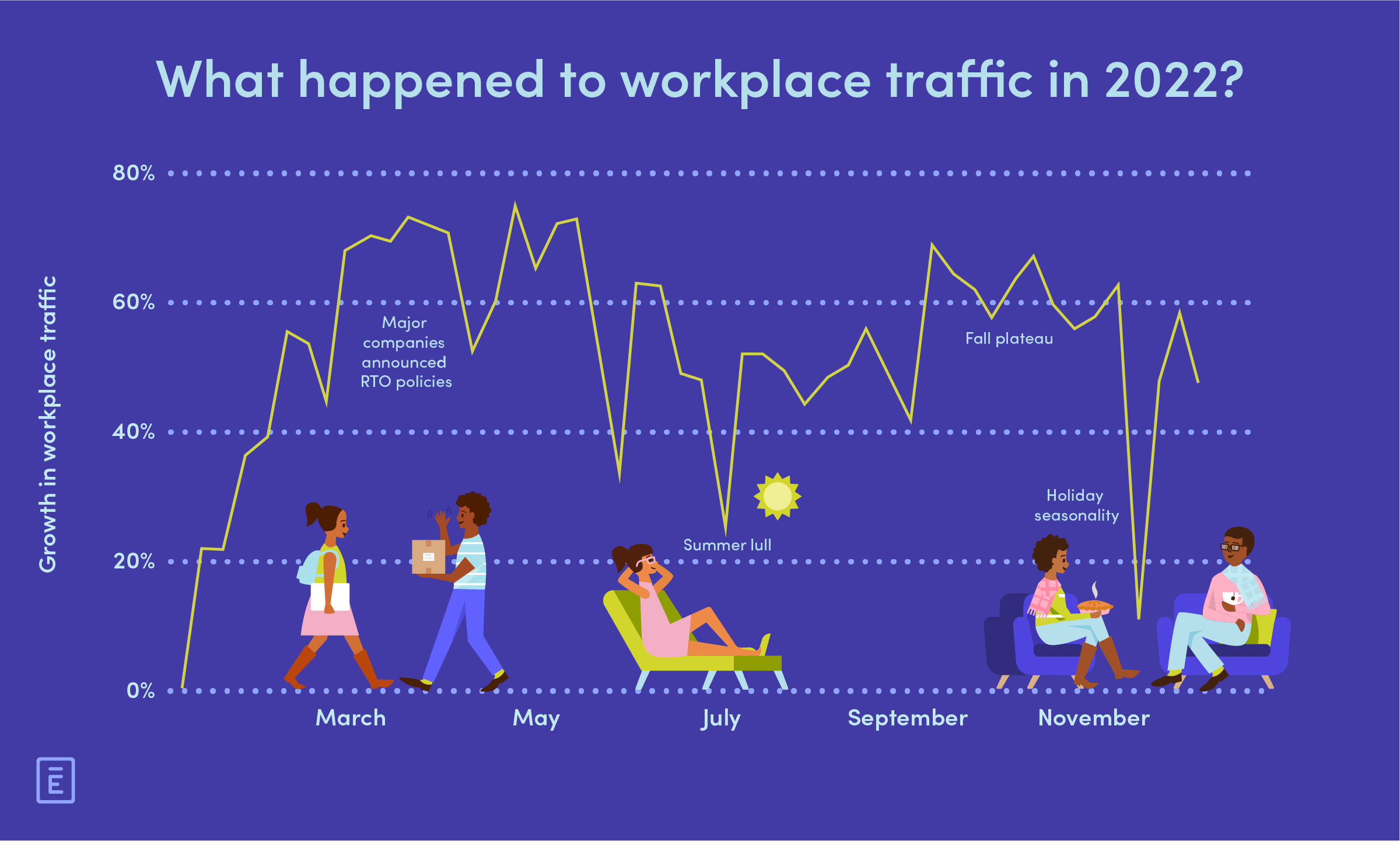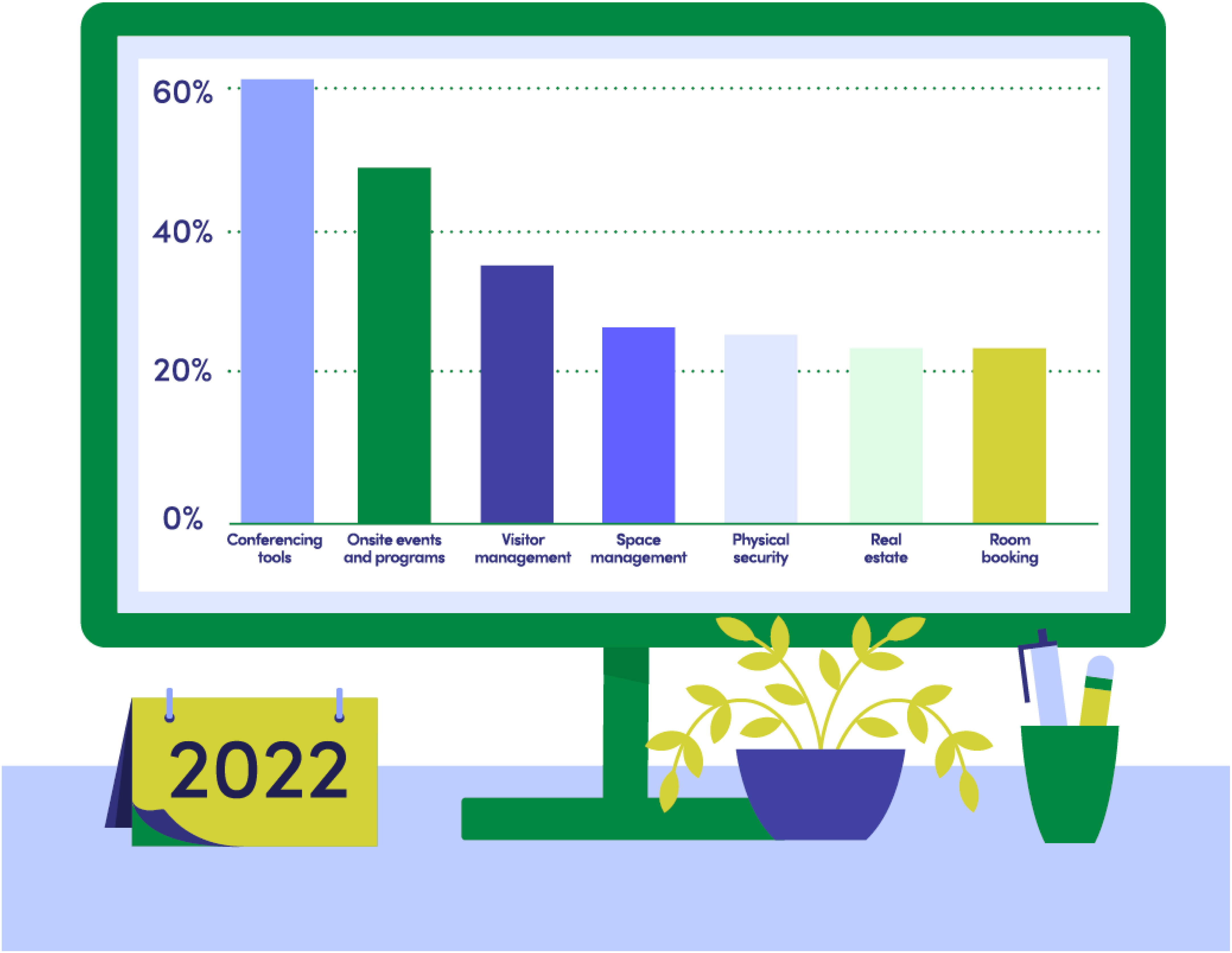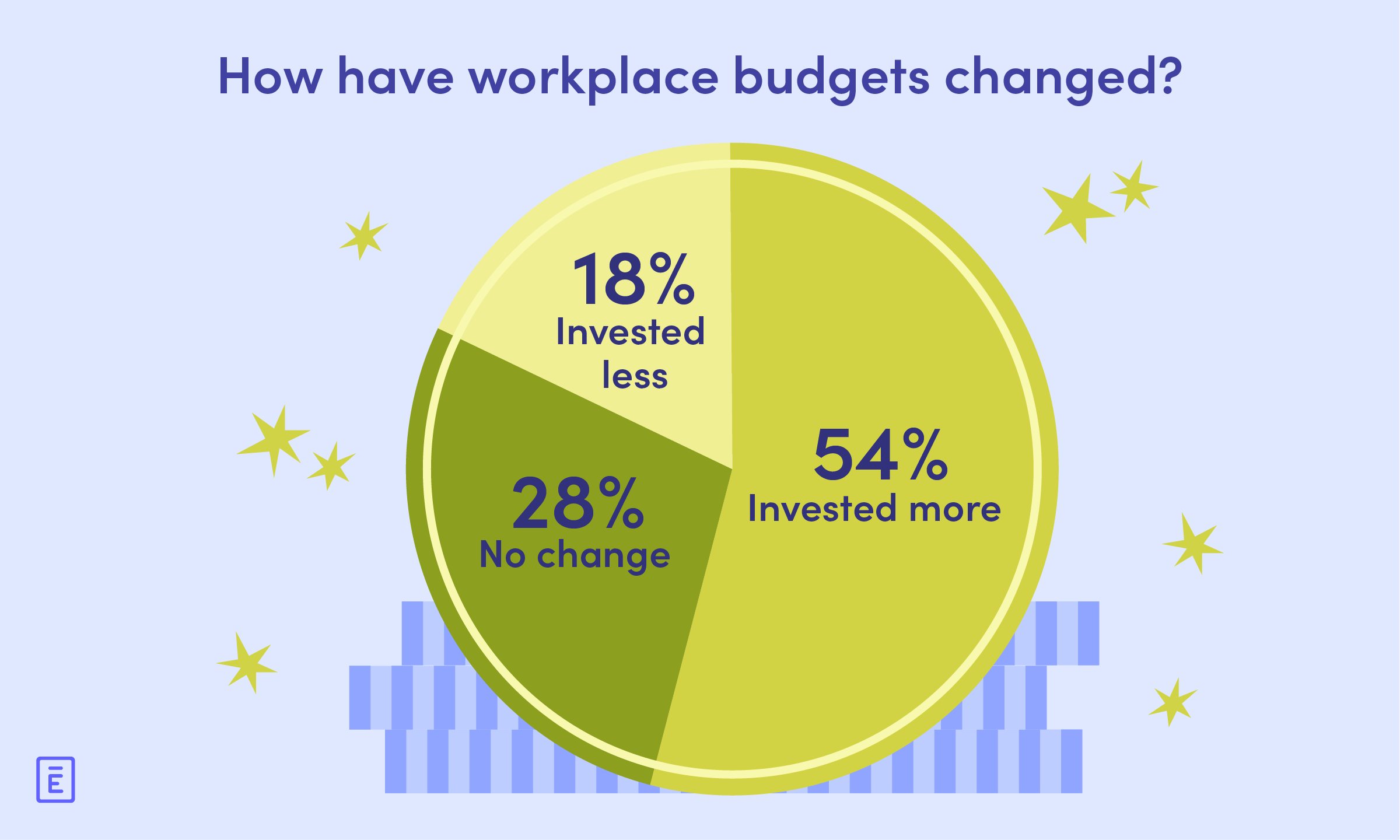The new owner of Twitter in his infamous first email to staff made it known how he feels about employees returning to the office: Come back or else. A 2:30 a.m. memo made it crystal clear: “The office is not optional.”
A new study from a firm founded by one of Twitter’s first 50 employees appears to reach the same conclusion, albeit with a gentler delivery: Yes, hybrid is where it’s at for now. But the physical workspace continues to exert meaningful influence.

All graphics courtesy of Envoy
Envoy, a San Francisco–based tech company whose product is used by companies worldwide to manage hybrid workplaces, heralded the first week of spring in March with the publication of “At Work: the 2023 workplace trends report.” Its lead finding: Eighty-two percent of leaders invested in their workplaces last year, and more than half of workplace leaders (54%) invested more in the workplace in 2022 than in the previous year. It’s a signal, Envoy says, that a physical footprint remains important for team building and collaboration because the workplace, especially a headquarters, is “the identity and soul of worklife.”
“Great things happen when people work together onsite,” said Larry Gadea, CEO and founder of Envoy. “And we’re seeing that in our data. More people are coming in and collaborating as teams. When employers take the bold step to bring employees back to the workplace on a regular basis, we’ll see big wins for their businesses and their people because nothing can replace in-person togetherness.”
Reached by email, Gadea says employees and leaders are more aligned on this topic than one might think.
 “The idea that we would stay remote forever was oversold. We’re finally waking from this fantasy where everyone thinks they’re 200% more productive and do their best work remotely.”
“The idea that we would stay remote forever was oversold. We’re finally waking from this fantasy where everyone thinks they’re 200% more productive and do their best work remotely.”
— Larry Gadea, CEO and Founder, Envoy
“Both groups agree that there’s power in gathering at the office a few times a week to collaborate, share and problem-solve,” he tells me. “In one of our recent surveys, 76% of office workers said being in the office is good for their mental well-being. Meanwhile most leaders (94%) and employees (84%) felt that office work life provided a sense of community.”
The Midweek Meetup
The data Gadea speaks of come from a survey of more than 250 workplace leaders across multiple sectors and from his company’s proprietary platform, encompassing around 31 million global workplace sign-ins, as well as desk and meeting room reservations, at 16,000 locations around the world, including from such clients as Warby Parker, Slack, Yelp, Pinterest and Mailchimp.
Among survey respondents, a leader from Moloco said, “I have found that adding personal touches and encouraging involvement in workspace customization has been successful in promoting more folks to come back into the office.” As for expectations, a respondent from Generate said, “We have ‘core days’ for employees required to be in office which are Tuesday, Wednesday, and Thursday. The hours are flexible, requiring a minimum of hours in office per day to be 10-3 at the least to allow for childcare, school, commuting, etc.”
“The primary expectation for the workplace is flexibility,” Todd Regan, senior strategic planning analyst at Computer Share, said in the report. “We believe a hybrid workforce helps maintain that flexibility. And when staff work in the office, we want to make their commute worthwhile. Collaboration, onboarding, and improved corporate culture are all things we feel are better suited in-person.”
An Envoy spokesperson says California accounts for about 22% of all U.S. workplace locations; New York 9%, followed by Texas 8% and Florida 6%. At the regional level, New York City, San Francisco, Los Angeles, Houston, Chicago, Atlanta, Washington, Boston, San Diego, Austin, San Jose, Dallas, Seattle, Denver and Miami are the top 15 cities in the U.S. by location and make up about 24% of all Envoy customer workplace locations in the country.
The Envoy report found that the District of Columbia and New York City had return-to-office growth rates that far surpassed other top U.S. metro areas. “Both regions are home to several tech industries, who tended to be the first to move the RTO needle,” the report found. “On the flip side, Dallas and Atlanta had slower growth rates in workplace traffic. Which cities booked the most desks? New York and San Francisco represented 58% of all desk reservations among the top metros. “These two tech hubs are home to a wealth of innovative companies that have been some of the early adopters of workplace technology, like hot desking,” the report states. “Both 2021 and 2022 allowed these metros to build a resilient hybrid infrastructure.”
Here are other takeaways from the report:
- Workplace foot traffic grew by 37% in 2022 over the previous year. “Yet, there was a lot of volatility throughout the year, which was likely the result of the economic downturn, shifting attendance policies and expected holiday lulls.”
- On average, the number of hybrid-first employees going into the workplace weekly jumped by 164% in 2022. “Eighty-two percent of employees visiting the workplace in a given week were hybrid-first, which is defined as going onsite one to three days. Meanwhile 18% were office-first. These employees showed up to the office more than three days in a given week.”
- Employees who are going into the workplace are building stronger relationships with each other, which boosts their mental health, Gadea claims. “The teams who work together in person perform better than those who are mixed or work remotely, especially when there are new-to-career people on the team.”
- Seventy-one percent of employees preferred going into the office in the middle of the week. “Traffic was highest on Tuesdays and Wednesdays, and lowest on Fridays.”
- Investment in office efficiency is top of mind for workplace leaders. “Of those that made more investments in their workplace last year, 63% of leaders said they invested in conferencing technology, such as monitors and cameras, to improve communication between those remote and those onsite. Fifty percent wisely invested in onsite events and programs; 36% into visitor management; and 27% into space management. Even with headlines proclaiming a commercial real estate slowdown, nearly a quarter (24%) invested in real estate expansion last year.”
- Thirty-six percent are planning for more onsite events and programs and 24% will be providing more food.
- Eighty-three percent of companies reconfigured their workspace to optimize for employee experience. “Many added more collaboration spaces (36%), more desks (23%) and more meeting rooms (22%). Nineteen percent made cost-saving decisions and reduced their real estate footprint with fewer desks (11%) and meeting rooms (4%).”
Envoy itself is looking to fill 10 positions, most of them in San Francisco, the poster child for the “urban doom loop” scenario of abandoned downtown office space and amenities since the pandemic’s onset. How has Envoy itself dealt with this challenge?
“It’s not as bad as people make it out to be,” Gadea says. “Mondays and Fridays are down but Tuesdays, Wednesdays and Thursdays have bounced back and are busy — to the point where there’s a lot of traffic again. Even with these challenges, the Bay Area is still one of the best talent pools around.”

Respondents to Envoy’s survey said these are the areas where workplace spend is being allocated
Envoy follows a strategy of being in office Tuesday through Thursday, a pattern many company workforces have adopted formally and informally. One of its customers is Mailchimp, now part of Intuit. A job description for the hiring of a new staff systems engineer stated the following: “Intuit Mailchimp is a hybrid workplace, giving employees the opportunity to collaborate in person with team members in our Atlanta and Brooklyn offices two or more days per week.”
Gadea says his own team understands why collaborating in person is indeed not a burden but an opportunity.
“We aim to hire people who understand the value and benefit of coming into the office and collaborating together,” he says. “It’s part of our culture. The idea that we would stay remote forever was oversold. We’re finally waking from this fantasy where everyone thinks they’re 200% more productive and do their best work remotely. In the meantime, companies have lost their ability to react quickly and solve complex problems. Remote work and other low-accountability environments are part of the reason. I believe being together in-person is important for culture, creativity and, ultimately, business outcomes. Some days of focused remote time can make sense, but teams not spending time physically in-office is a significant long-term business risk.”
Just Add Sweeteners
Office REITs understand that risk more than Most. Many prominent REITs received a negative outlook in a recent portfolio review by S&P Global Ratings. “We expect office assets to underperform other real estate property types over the next two years given expected pressure to net effective rents and occupancy levels,” said Ana Lai, senior director real estate, S&P Global Ratings. “Growth for the rated office REIT sector will likely be muted overall, with relatively flat to slightly negative NOI growth projected in 2023 given our expectation for leasing activity to remain slow, with office landlords wielding limited pricing power.”

New statistics from the U.S Census Bureau show that workers of all income levels were more likely to work from home in 2021 than in 2019, with higher earners the most likely to do so.
Some areas are going out of their way to accommodate the work-from-home (WFH) contingent: The Jamaica Special Economic Zone Authority recently established a permanent work-from-home framework for companies operating in SEZs that allows up to 30% of the companies’ workers to work remotely.
In addition to employers sweetening the workplace with amenities and perks, developers are too. One example is ROW DTLA, a 32-acre mixed-use retail and office development in the Los Angeles Arts District that touts the attractiveness of an environment once deemed to be the exclusive domain of creatives to sectors such as law and financial firms. Think pizzeria, dog treats, workouts and facials. A recent release from ROW DTLA and JLL notes the arrival of such tenants as legal services firm Umhofer, Mitchell & King LLP; financial lender Lendistry; and global consulting firm Actum LLC. Other tenants include Virgin Hyperloop and HOK Group.

A healthy proportion of Envoy respondents say they plan to invest in their workspaces rather than pull back.
ROW DTLA’s location was originally the LA Terminal Market, built from 1917 to 1923 along the Southern Pacific Railroad. It continues to be a major hub for the distribution of produce across the region — work not allowing WFH as an option. But for others, it is.
“The vibrancy of the district’s amenities and co-tenancies, the multitude of outdoor and event spaces and ample parking, the safety of officing in a city within a city, and the opportunity to mitigate upfront capital with our pre-built spaces, are all resounding themes from each new tenant we’ve attracted,” said Jaclyn Ward, JLL managing director.
Working Remotely vs. Not Remotely Working
Not all tech company reports agree. In April, another San Francisco-based company in the workspace planning and coordination space, Scoop, released “The Flex Report Q2 2023” analyzing remote and hybrid work data that was in contrast to a recent U.S. Bureau of Labor Statistics (BLS) survey that found only 27.5% of all private firms had employees working hybrid or remotely in 2022. Scoop’s data from more than 4,000 companies in more than 25,000 office locations (admittedly a subset of the much larger BLS sample) employing more than 100 million people showed instead that 58% of companies offer work location flexibility.
Moreover, the data showed a decided difference in strategies between companies founded before or after 2000. Eighty-two percent of companies founded post-2000 offer some flexibility, while only 53% of companies founded pre-2000 offer flexibility. “Even when you remove tech, companies formed since 2000 are overwhelmingly flexible,” Scoop reported. “If you look at non-tech companies that started since 2010, the percentage offering flexibility increases to 76%.” And companies started after 2010 are three more likely (62%) to embrace full flexibility.”
"While the pandemic forced almost everyone that could work from home to do so, the trend toward remote access was already well established,” said Rob Sadow, CEO of Scoop and creator of the Flex Index. “Only 20 years ago, smartphones weren’t a thing, many people didn’t have home computers, and access to the internet wasn’t a given, so all work de facto took place in the office. The rate of change since then is staggering. With nearly ubiquitous WiFi, rapidly improving remote communication tools and the increasingly global nature of work, all employees at a company being in the same office at the same time is quickly becoming a thing of the past.”
Envoy’s Larry Gadea doesn’t necessarily say everyone needs to show up at the same place at the same time. But when they do, things pop.
“Employers are now looking at team productivity and how work gets done as opposed to individual performance – a shift from a few years ago,” he tells me. “In the past, managers didn’t care how work was accomplished. Now they suspect that the relationships people build along the way with coworkers are critical to getting work done right and in a smart way.
“Our hardest problems can be solved when we come together on-site,” Gadea says. “Isolation will kill any company’s chance of success — especially in this economic environment. Though working in the office won’t resolve all of our challenges, it can certainly help create an environment that does. This year, some companies will stand out from the rest. Not because they build the best widget or they have the hardest working employees, but because of intentional steps they’ve taken to rebuild a strong workplace community. These are the organizations that will win.”

